| Pope No. | Motto (Translation) | Regnal Name (Reign) | Name | Historical Reference or Explanation | Coat of Arms |
|---|---|---|---|---|---|
| Ex caſtro Tiberis. | Cœleſtinus. ij. | Typhernas. | |||
| 167 | 1. From a castle of the Tiber | Celestine II (1143–1144) | Guido de Castello | An inhabitant of Tifernum. Born in Città di Castello, Umbria, on the banks of the Tiber.[5] | |
| Inimicus expulſus. | Lucius. ij. | De familia Caccianemica. | |||
| 168 | 2. Enemy expelled | Lucius II (1144–1145) | Gherardo Caccianemici del Orso | Of the Caccianemici family. This motto refers to Gherardo Caccianemici’s surname. “Cacciare” means “to hunt”,[6] and “nemici” is the Italian word for “enemies”. As his name foreshadowed, Caccianemici would be driven from Rome by his own subjects.[7] | |
| Ex magnitudine mõtis. | Eugenius. iij. | Patria Ethruſcus oppido Montis magni. | |||
| 169 | 3. Out of the greatness of the mountain | Eugene III (1145–1153) | Bernardo dei Pagnelli di Montemagno | Tuscan by nation, from the town of Montemagno. The motto refers to Pope Eugene’s last name, “Montemagno.”[8] | |
| Abbas Suburranus. | Anaſtaſius. iiij. | De familia Suburra. | |||
| 170 | 4. Suburran abbot | Anastasius IV (1153–1154) | Corrado di Suburra | From the Suburra family. | |
| De rure albo. | Adrianus. iiij. | Vilis natus in oppido Sancti Albani. | |||
| 171 | 5. From the white countryside | Adrian IV (1154–1159) | Nicholas Breakspear | Humbly born in the town of St. Albans. Educated at the St Albans School in Hertfordshire. Nicholas Breakspear was the bishop of Albano before becoming pope.[9] | |
| Ex tetro carcere. | Victor. iiij. | Fuit Cardinalis S. Nicolai in carcere Tulliano. | |||
| 6. Out of a loathsome prison. | Victor IV, Antipope (1159–1164) | Ottaviano Monticello | He was a cardinal of St. Nicholas in the Tullian prison. | ||
| Via Tranſtiberina. | Calliſtus. iij. [sic] | Guido Cremenſis Cardinalis S. Mariæ Tranſtiberim. | |||
| 7. Road across the Tiber. | Paschal III, Antipope (1164–1168) | Guido di Crema | Guido of Crema, Cardinal of St. Mary across the Tiber. As a cardinal, he had held the title of Santa Maria in Trastevere.[10] | ||
| De Pannonia Thuſciæ. | Paſchalis. iij. [sic] | Antipapa. Hungarus natione, Epiſcopus Card. Tuſculanus. | |||
| 8. From Tusculan Hungary | Callixtus III, Antipope (1168–1178) | Giovanni di Strumi | Antipope. A Hungarian by birth, Cardinal Bishop of Tusculum. He was John, Abbot of Struma, originally from Hungary.[11] | ||
| Ex anſere cuſtode. | Alexander. iij. | De familia Paparona. | |||
| 172 | 9. Out of the guardian goose | Alexander III (1159–1181) | Orlando Bandinelli Paparoni | Of the Paparoni family. His family's coat of arms had a goose on it.[12] | |
| Lux in oſtio. | Lucius. iij. | Lucenſis Card. Oſtienſis. | |||
| 173 | 10. A light in the entrance | Lucius III (1181–1185) | Ubaldo Allucingoli | A Luccan Cardinal of Ostia. In 1159, he became Cardinal Bishop of Ostia.[13] Lux may also be a wordplay on Lucius. | |
| Sus in cribro. | Vrbanus. iij. | Mediolanenſis, familia cribella, quæ Suem pro armis gerit. | |||
| 174 | 11. Pig in a sieve | Urban III (1185–1187) | Umberto Crivelli | A Milanese, of the Cribella (Crivelli) family, which bears a pig for arms. His family name Crivelli means "a sieve" in Italian. | |
| Enſis Laurentii. | Gregorius. viij. | Card. S. Laurentii in Lucina, cuius inſignia enſes falcati. | |||
| 175 | 12. The sword of St. Lawrence | Gregory VIII (1187) | Alberto De Morra | Cardinal of St. Lawrence in Lucina, of whom the arms were curved swords. He had been the Cardinal of St. Lawrence[14] and his armorial bearing was a drawn sword.[15] | |
| De Schola exiet.[16] | Clemens. iij. | Romanus, domo Scholari. | |||
| 176 | 13 He will come from school | Clement III (1187–1191) | Paolo Scolari | A Roman, of the house of Scolari. His family name was Scolari. | |
| De rure bouenſi. | Cœleſtinus. iij. | Familia Bouenſi. | |||
| 177 | 14. From cattle country | Celestine III (1191–1198) | Giacinto Bobone | Bovensis (Bobone) family. He was from the Bobone family; a wordplay on cattle (boves). | |
| Comes Signatus. | Innocentius. iij. | Familia Comitum Signiæ. | |||
| 178 | 15. Designated count | Innocent III (1198–1216) | Lotario dei Conti di Segni | Family of the Counts of Signia (Segni) Descendant of the Segni family. |  |
| Canonicus de latere. | Honorius. iij. | Familia Sabella, Canonicus S. Ioannis Lateranensis. | |||
| 179 | 16. Canon from the side | Honorius III (1216–1227) | Cencio Savelli | Savelli family, canon of St. John Lateran He was a canon for the church of Santa Maria Maggiore, and had served as papal chamberlain in 1188.[17] |  |
| Auis Oſtienſis. | Gregorius. ix. | Familia Comitum Signiæ Epiſcopus Card. Oſtienſis. | |||
| 180 | 17. Bird of Ostia | Gregory IX (1227–1241) | Ugolino dei Conti di Segni | Family of the Counts of Segni, Cardinal Bishop of Ostia. Before his election to the papacy, Ugolino dei Conti was the Cardinal Bishop of Ostia, and the family coat of arms bear a bird on a gules background.[18] |  |
| Leo Sabinus. | Cœleſtinus iiij. | Mediolanenſis, cuius inſignia Leo, Epiſcopus Card. Sabinus. | |||
| 181 | 18. Sabine Lion | Celestine IV (1241) | Goffredo Castiglioni | A Milanese, whose arms were a lion, Cardinal Bishop of Sabina. He was Cardinal Bishop of Sabina[19] and his armorial bearing had a lion in it. Also a play on words, referring to the pope's last name, Castiglioni. |  |
| Comes Laurentius. | Innocentius iiij. | domo flisca, Comes Lauaniæ, Cardinalis S. Laurentii in Lucina. | |||
| 182 | 19. Count Lawrence | Innocent IV (1243–1254) | Sinibaldo Fieschi | Of the house of Flisca (Fieschi), Count of Lavagna, Cardinal of St. Lawrence in Lucina. He was the Cardinal-Priest of San Lorenzo in Lucca,[20] and his father was the Count of Lavagna.[21] |  |
| Signum Oſtienſe. | Alexander iiij. | De comitibus Signiæ, Epiſcopus Card. Oſtienſis. | |||
| 183 | 20. Sign of Ostia | Alexander IV (1254–1261) | Renaldo dei Signori di Ienne | Of the counts of Segni, Cardinal Bishop of Ostia. He was Cardinal Bishop of Ostia and member of the Conti-Segni family.[22] |  |
| Hieruſalem Campanię. | Vrbanus iiii. | Gallus, Trecenſis in Campania, Patriarcha Hieruſalem. | |||
| 184 | 21. Jerusalem of Champagne | Urban IV (1261–1264) | Jacques Pantaleon | A Frenchman, of Trecae (Troyes) in Champagne, Patriarch of Jerusalem. Native of Troyes, Champagne, later patriarch of Jerusalem.[23] |  |
| Draco depreſſus. | Clemens iiii. | cuius inſignia Aquila vnguibus Draconem tenens. | |||
| 185 | 22. Dragon pressed down | Clement IV (1265–1268) | Guido Fulcodi | Whose badge is an eagle holding a dragon in his talons. His coat of arms had an eagle crushing a dragon. | 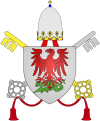 |
| Anguinus uir. | Gregorius. x. | Mediolanenſis, Familia vicecomitum, quæ anguẽ pro inſigni gerit. | |||
| 186 | 23. Snaky man | Gregory X (1271–1276) | Tebaldo Visconti | A Milanese, of the family of Viscounts (Visconti), which bears a snake for arms. The Visconti coat of arms had a large serpent devouring a male child feet first.[24] | 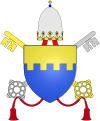 |
| Concionator Gallus. | Innocentius. v. | Gallus, ordinis Prædicatorum. | |||
| 187 | 24. French Preacher | Innocent V (1276) | Pierre de Tarentaise | A Frenchman, of the Order of Preachers. He was born in south-eastern France and was a member of the order of Preachers.[25] |  |
| Bonus Comes. | Adrianus. v. | Ottobonus familia Fliſca ex comitibus Lauaniæ. | |||
| 188 | 25. Good Count/companion | Adrian V (1276) | Ottobono Fieschi | Ottobono, of the Fieschi family, from the counts of Lavagna. He was a count and a wordplay on "good" can be made with his name, Ottobono. |  |
| Piſcator Thuſcus. | Ioannes. xxi. | antea Ioannes Petrus Epiſcopus Card. Tuſculanus. | |||
| 189 | 26. Tuscan Fisherman | John XXI (1276–1277) | Pedro Julião | Formerly John Peter, Cardinal Bishop of Tusculum. John XXI had been the Cardinal Bishop of Tusculum.[26] | 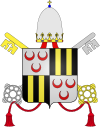 |
| Roſa compoſita. | Nicolaus. iii. | Familia Vrſina, quæ roſam in inſigni gerit, dictus compoſitus. | |||
| 190 | 27. Composite Rose | Nicholas III (1277–1280) | Giovanni Gaetano Orsini | Of the Ursina (Orsini) family, which bears a rose on its arms, called 'composite'. He bore a rose in his coat of arms.[27] |  |
| Ex teloneo liliacei Martini. | Martinus. iiii. | cuius inſignia lilia, canonicus, & theſaurarius S. Martini Turonen[sis]. | |||
| 191 | 28. From the tollhouse of lilied Martin | Martin IV (1281–1285) | Simone de Brion | Whose arms were lilies, canon and treasurer of St. Martin of Tours. He was Canon and Treasurer at the Church of St. Martin in Tours, France. | 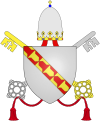 |
| Ex roſa leonina. | Honorius. iiii. | Familia Sabella inſignia roſa à leonibus geſtata. | |||
| 192 | 29. Out of the leonine rose | Honorius IV (1285–1287) | Giacomo Savelli | Of the Sabella (Savelli) family, arms were a rose carried by lions. His coat of arms were emblazoned with two lions supporting a rose.[27] |  |
| Picus inter eſcas. | Nicolaus. iiii. | Picenus patria Eſculanus.[28] | |||
| 193 | 30. Woodpecker between food | Nicholas IV (1288–1292) | Girolamo Masci | A Picene by nation, of Asculum (Ascoli). He was from Ascoli, now called Ascoli Piceno, in Picene country. | 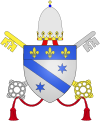 |
| Ex eremo celſus. | Cœleſtinus. v. | Vocatus Petrus de morrone Eremita. | |||
| 194 | 31. Raised out of the desert | St. Celestine V (1294) | Pietro Di Murrone | Called Peter de Morrone, a hermit. Prior to his election he was a hermit (eremita, literally a dweller in the eremus, or desert). Also a play on words (celsus/Coelestinus), referring to the pope's chosen name Celestine. |  |
| Ex undarũ bn̑dictione. | Bonifacius. viii. | Vocatus prius Benedictus, Caetanus, cuius inſignia undæ. | |||
| 195 | 32. From the blessing of the waves | Boniface VIII (1294–1303) | Benedetto Caetani | Previously called Benedict, of Gaeta, whose arms were waves. His coat of arms had a wave through it. Also a play on words, referring to the pope's Christian name, "Benedetto."[27] |  |
| Concionator patereus. [sic] | Benedictus. xi. | qui uocabatur Frater Nicolaus, ordinis Prædicatorum. | |||
| 196 | 33. Preacher From Patara | Benedict XI (1303–1304) | Nicholas Boccasini | Who was called Brother Nicholas, of the order of Preachers. This Pope belonged to the Order of Preachers. Patara was the hometown of Saint Nicholas, a namesake of this Pope (born Nicholas Boccasini).[29] |  |
| De feſſis aquitanicis. | Clemens V. | natione aquitanus, cuius inſignia feſſæ erant. | |||
| 197 | 34. From the misfortunes/fesses of Aquitaine | Clement V (1305–1314) | Bertrand de Got | An Aquitanian by birth, whose arms were fesses. He was a native of St. Bertrand de Comminges in Aquitaine, and eventually became Archbishop of Bordeaux, also in Aquitaine. His coat of arms displays three horizontal bars, known in heraldry as fesses. | 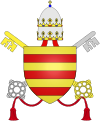 |
| De ſutore oſſeo. | Ioannes XXII. | Gallus, familia Oſſa, Sutoris filius. | |||
| 198 | 35. From a bony cobbler | John XXII (1316–1334) | Jacques Duese | A Frenchman, of the Ossa family, son of a cobbler. His family name was Duèze, D'Euze, D'Euzes, or Euse, the last of which might be back-translated into Latin as Ossa "bones". The popular legend that his father was a cobbler is probably untrue. | 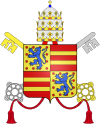 |
| Coruus ſchiſmaticus. | Nicolaus V. | qui uocabatur F. Petrus de corbario, contra Ioannem XXII. Antipapa Minorita. | |||
| 36. Schismatic crow | Nicholas V, Antipope (1328–1330) | Pietro Rainalducci di Corvaro | Who was called Brother Peter of Corbarium (Corvaro), the Minorite antipope opposing John XXII. The motto is a play on words, referring to Pietro di Corvaro's last name. | ||
| Frigidus Abbas. | Benedictus XII. | Abbas Monaſterii fontis frigidi. | |||
| 199 | 37. Cold abbot | Benedict XII (1334–1342) | Jacques Fournier | Abbot of the monastery of the cold spring. He was an abbot in the monastery of Fontfroide ("cold spring").[30] |  |
| De roſa Attrebatenſi. | Clemens VI. | Epiſcopus Attrebatenſis, cuius inſignia Roſæ. | |||
| 200 | 38. From the rose of Arras | Clement VI (1342–1352) | Pierre Roger | Bishop of Arras, whose arms were roses. He was Bishop of Arras, (Latin: Episcopus Atrebatensis),[31] and his armorial bearings were emblazoned with six roses.[32] | 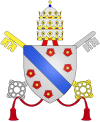 |
| De mõtibus Pãmachii. | Innocentius VI. | Cardinalis SS. Ioannis & Pauli. T. Panmachii, cuius inſignia ſex montes erant. | |||
| 201 | 39. From the mountains of Pammachius | Innocent VI (1352–1362) | Etienne Aubert | Cardinal of Saints John and Paul, Titulus of Pammachius, whose arms were six mountains. Pope Innocent was born at Mont in the diocese of Limoges, France, and he rose to prominence as the Bishop of Clermont.[33] He had been a cardinal priest with the title of St. Pammachius (i.e., the church of SS. Giovanni e Paolo in Rome)[34] |  |
| Gallus Vicecomes. | Vrbanus V. | nuncius Apoſtolicus ad Vicecomites Mediolanenſes. | |||
| 202 | 40. French viscount | Urban V (1362–1370) | Guglielmo De Grimoard | Apostolic nuncio to the Viscounts of Milan. He was born of a noble French family. |  |
| Nouus de uirgine forti. | Gregorius XI. | qui uocabatur Petrus Belfortis, Cardinalis S. Mariæ nouæ. | |||
| 203 | 41. New man from the strong virgin | Gregory XI (1370–1378) | Pierre Roger de Beaufort | Who was called Peter Belfortis (Beaufort), Cardinal of New St. Mary's. From the Beaufort family and Cardinal of Santa Maria Nuova[35] |  |
| Decruce Apoſtolica. [sic] | Clemens VII. | qui fuit Preſbyter Cardinalis SS. XII. Apoſtolorũ cuius inſignia Crux. | |||
| 42. From the apostolic cross | Clement VII, Antipope (1378–1394) | Robert, Count of Geneva | Who was Cardinal Priest of the Twelve Holy Apostles, whose arms were a cross. His coat of arms showed a cross, quarterly pierced.[36] | 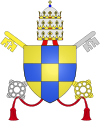 | |
| Luna Coſmedina. | Benedictus XIII. | antea Petrus de Luna, Diaconus Cardinalis S. Mariæ in Coſmedin. | |||
| 43. Cosmedine moon. | Benedict XIII, Antipope (1394–1423) | Peter de Luna | Formerly Peter de Luna, Cardinal Deacon of St. Mary in Cosmedin. He was the famous Peter de Luna, Cardinal of Santa Maria in Cosmedin.[37] | 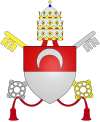 | |
| Schiſma Barchinoniũ. | Clemens VIII. | Antipapa, qui fuit Canonicus Barchinonenſis. | |||
| 44. Schism of the Barcelonas | Clement VIII, Antipope (1423–1429) | Gil Sanchez Muñoz | Antipope, who was a canon of Barcelona. [38] | ||
| De inferno prægnãti. | Vrbanus VI. | Neapolitanus Pregnanus, natus in loco quæ dicitur Infernus. | |||
| 204 | 45. From a pregnant hell. | Urban VI (1378–1389) | Bartolomeo Prignano | The Neapolitan Prignano, born in a place which is called Inferno. His family name was Prignano or Prignani, and he was native to a place called Inferno near Naples.[39] | 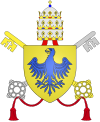 |
| Cubus de mixtione. | Bonifacius. IX. | familia tomacella à Genua Liguriæ orta, cuius inſignia Cubi. | |||
| 205 | 46. Cube from a mixture | Boniface IX (1389–1404) | Pietro Tomacelli | Of the Tomacelli family, born in Genoa in Liguria, whose arms were cubes. His coat of arms includes a bend checky — a wide stripe with a checkerboard pattern.[32] |  |
| De meliore ſydere. | Innocentius. VII. | uocatus Coſmatus de melioratis Sulmonenſis, cuius inſignia ſydus. | |||
| 206 | 47. From a better star | Innocent VII (1404–1406) | Cosmo Migliorati | Called Cosmato dei Migliorati of Sulmo, whose arms were a star. The prophecy is a play on words, "better" (melior) referring to the pope's last name, Migliorati (Meliorati). There is a shooting star on his coat of arms.[32] |  |
| Nauta de Ponte nigro. | Gregorius XII. | Venetus, commendatarius eccleſiæ Nigropontis. | |||
| 207 | 48. Sailor from a black bridge | Gregory XII (1406–1415) | Angelo Correr | A Venetian, commendatary of the church of Negroponte. Was Bishop of Venice and the Bishop of Chalcice, Chalcice being located on the Isle of Negropont |  |
| Flagellum ſolis. | Alexander. V. | Græcus Archiepiſcopus Mediolanenſis, inſignia Sol. | |||
| 49. Whip of the sun | Alexander V, Antipope (1409–1410) | Petros Philarges | A Greek, Archbishop of Milan, whose arms were a sun. His coat of arms had a large sun on it. Also, a play on words, referring to the pope's last name, "Philarges."[40] | 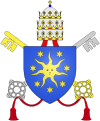 | |
| Ceruus Sirenæ. | Ioannes XXIII. | Diaconus Cardinalis S. Euſtachii, qui cum ceruo depingitur, Bononiæ legatus, Neapolitanus. | |||
| 50. Stag of the siren | John XXIII, Antipope (1410–1415) | Baldassarre Cossa | Cardinal Deacon of St. Eustace, who is depicted with a stag; legate of Bologna, a Neapolitan. Baldassarre Cossa was a cardinal with the title of St. Eustachius.[41] St. Eustachius converted to Christianity after he saw a stag with a cross between its horns. Baldassarre's family was originally from Naples, which has the emblem of the siren. | ||
| Corona ueli aurei. | Martinus V. | familia colonna, Diaconus Cardinalis S. Georgii ad uelum aureum. | |||
| 208 | 51. Crown of the golden curtain | Martin V (1417–1431) | Oddone Colonna | Of the Colonna family, Cardinal Deacon of St. George at the golden curtain. Oddone Colonna was the Cardinal Deacon of San Giorgio in Velabro.[42] The word "Velabrum" is here interpreted as derived from "velum aureum", or golden veil.[43] His coat of arms had a golden crown resting atop a column.[44] |  |
| Lupa Cœleſtina, | Eugenius. IIII. | Venetus, canonicus antea regularis Cœleſtinus, & Epiſcopus Senẽſis. | |||
| 209 | 52. Heavenly she-wolf | Eugene IV (1431–1447) | Gabriele Condulmaro | A Venetian, formerly a regular Celestine canon, and Bishop of Siena. He belonged to the order of the Celestines and was the Bishop of Siena which bears a she-wolf on its arms. |  |
| Amator Crucis. | Felix. V. | qui uocabatur Amadæus Dux Sabaudiæ, inſignia Crux. | |||
| 53. Lover of the cross | Felix V, Antipope (1439–1449) | Amadeus Duke of Savoy | Who was called Amadeus, Duke of Savoy, arms were a cross. He was previously the count of Savoy and therefore his coat of arms contained the cross of Savoy.[45] Also, the prophecy is a play on words, referring to the antipope's Christian name, "Amadeus." |  | |
| De modicitate Lunæ. | Nicolaus V. | Lunenſis de Sarzana, humilibus parentibus natus. | |||
| 210 | 54. From the meanness of Luna | Nicholas V (1447–1455) | Tommaso Parentucelli | A Lunese of Sarzana, born to humble parents. He was born in Sarzana in the diocese of Luni, the ancient name of which was Luna. | 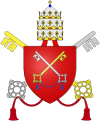 |
| Bos paſcens. | Calliſtus. III. | Hiſpanus, cuius inſignia Bos paſcens. | |||
| 211 | 55. Pasturing ox | Callixtus III (1455–1458) | Alfonso Borja | A Spaniard, whose arms were a pasturing ox. Alonso Borgia's coat of arms had a grazing ox.[44] | 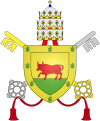 |
| De Capra & Albergo. | Pius. II. | Senenſis, qui fuit à Secretis Cardinalibus Capranico & Albergato. | |||
| 212 | 56. From a nanny-goat and an inn | Pius II (1458–1464) | Enea Silvio de Piccolomini | A Sienese, who was secretary to Cardinals Capranicus and Albergatus. He had been secretary to Cardinal Domenico Capranica and Cardinal Albergatti before he was elected Pope.[46] |  |
| De Ceruo & Leone. | Paulus. II. | Venetus, qui fuit Commendatarius eccleſiæ Ceruienſis, & Cardinalis tituli S. Marci. | |||
| 213 | 57. From a stag and lion | Paul II (1464–1471) | Pietro Barbo | A Venetian, who was Commendatary of the church of Cervia, and Cardinal of the title of St. Mark. Possibly refers to his Bishopric of Cervia (punning on cervus, "a stag") and his Cardinal title of St. Mark (symbolized by a winged lion).[47] |  |
| Piſcator minorita. | Sixtus. IIII. | Piſcatoris filius, Franciſcanus. | |||
| 214 | 58. Minorite fisherman | Sixtus IV (1471–1484) | Francesco Della Rovere | Son of a fisherman, Franciscan. He was born the son of a fisherman and a member of the Franciscans, also known as "Minorites". |  |
| Præcurſor Siciliæ. | Innocentius VIII. | qui uocabatur Ioãnes Baptiſta, & uixit in curia Alfonſi regis Siciliæ. | |||
| 215 | 59. Forerunner of Sicily | Innocent VIII (1484–1492) | Giovanni Battista Cibò | Who was called John Baptist, and lived in the court of Alfonso, king of Sicily. Giovanni Battista Cibò was named after John the Baptist, the precursor of Christ. In his early years, Giovanni served as the Bishop of Molfetta in Sicily.[48] |  |
| Bos Albanus in portu. | Alexander VI. | Epiſcopus Cardinalis Albanus & Portuenſis, cuius inſignia Bos. | |||
| 216 | 60. Bull of Alba in the harbor | Alexander VI (1492–1503) | Rodrigo de Borgia | Cardinal Bishop of Albano and Porto, whose arms were a bull. In 1456, he was made a Cardinal and he held the titles of Cardinal Bishop of Albano and Porto. [49] Also, Pope Alexander had a red bull on his coat of arms[50] |  |
| De paruo homine. | Pius. III. | Senenſis, familia piccolominea. | |||
| 217 | 61. From a small man | Pius III (1503) | Francesco Todeschini Piccolomini | A Sienese, of the Piccolomini family. His family name was Piccolomini, from piccolo "small" and uomo "man". |  |
| Fructus Iouis iuuabit. | Iulius. II. | Ligur, eius inſignia Quercus, Iouis arbor. | |||
| 218 | 62. The fruit of Jupiter will help | Julius II (1503–1513) | Giuliano Della Rovere | A Genoese, his arms were an oak, Jupiter's tree. On his arms was an oak tree, which was sacred to Jupiter.[50] Pope Julius' family name, "Della Rovere," literally means "of the oak."[51] |  |
| De craticula Politiana. | Leo. X. | filius Laurentii medicei, & ſcholaris Angeli Politiani. | |||
| 219 | 63. From a Politian gridiron | Leo X (1513–1521) | Giovanni de Medici | Son of Lorenzo de' Medici, and student of Angelo Poliziano. His educator and mentor was the distinguished humanist and scholar, Angelo Poliziano. The “Gridiron” is the motto evidently refers to St. Lawrence, who was martyred on a gridiron. This is a rather elliptical allusion to Lorenzo the Magnificent, who was Giovanni’s father.[52] |  |
| Leo Florentius. | Adrian. VI. | Florẽtii filius, eius inſignia Leo. | |||
| 220 | 64. Florentian lion | Adrian VI (1522–1523) | Adriaen Florenszoon Boeyens | Son of Florentius, his arms were a lion. His coat of arms had two lions on it,[50] and his name is sometimes given as Adriaan Florens, or other variants, from his father's first name Florens (Florentius). |  |
| Flos pilei ægri. | Clemens. VII. | Florentinus de domo medicea, eius inſignia pila, & lilia. | |||
| 221 | 65. Flower of the sick man's pill[53] | Clement VII (1523–1534) | Giulio de Medici | A Florentine of the Medicean house, his arms were pill-balls and lilies. The Medici coat of arms were emblazoned with six medical balls. One of these balls, the largest of the six, was emblazoned with the Florentine lily.[50] |  |
| Hiacinthus medicorũ. | Paulus. III. | Farneſius, qui lilia pro inſignibus geſtat, & Card. fuit SS. Coſme, & Damiani. | |||
| 222 | 66. Hyacinth of the physicians | Paul III (1534–1549) | Alessandro Farnese | Farnese, who bore lilies for arms, and was Cardinal of Saints Cosmas and Damian. Pope Paul's coat of arms were charged with six hyacinths.[50] |  |
| De corona montana. | Iulius. III. | antea uocatus Ioannes Maria de monte. | |||
| 223 | 67. From the mountainous crown | Julius III (1550–1555) | Giovanni Maria Ciocchi del Monte | Formerly called Giovanni Maria of the Mountain (de Monte) His coat of arms showed mountains and palm branches laid out in a pattern much like a crown.[50] |  |
| Frumentum flocidum. [sic] | Marcellus. II. | cuius inſignia ceruus & frumẽtum, ideo floccidum, quod pauco tempore uixit in papatu. | |||
| 224 | 68. Trifling grain | Marcellus II (1555) | Marcello Cervini | Whose arms were a stag and grain; 'trifling', because he lived only a short time as pope. His coat of arms showed a stag and ears of wheat.[50] |  |
| De fide Petri. | Paulus. IIII. | antea uocatus Ioannes Petrus Caraffa. | |||
| 225 | 69. From Peter's faith | Paul IV (1555–1559) | Giovanni Pietro Caraffa | Formerly called John Peter Caraffa. He is said to have used his second Christian name Pietro. |  |
| Eſculapii pharmacum. | Pius. IIII. | antea dictus Io. Angelus Medices. | |||
| 226 | 70. Aesculapius' medicine | Pius IV (1559–1565) | Giovanni Angelo de Medici | Formerly called Giovanni Angelo Medici. His family name was Medici. |  |
| Angelus nemoroſus. | Pius. V. | Michael uocatus, natus in oppido Boſchi. | |||
| 227 | 71. Angel of the grove | St. Pius V (1566–1572) | Antonio Michele Ghisleri | Called Michael, born in the town of Bosco. He was born in Bosco, (Lombardy); the placename means grove. His name was 'Antonio Michele Ghisleri', and Michele relates to the archangel. |  |
| Medium corpus pilarũ. | Gregorius. XIII. | cuius inſignia medius Draco, Cardinalis creatus à Pio. IIII. qui pila in armis geſtabat. | |||
| 228 | 72. Half body of the balls | Gregory XIII (1572–1585) | Ugo Boncompagni | Whose arms were a half-dragon; a Cardinal created by Pius IV who bore balls in his arms. The "balls" in the motto refer to Pope Pius IV, who had made Gregory a cardinal. Pope Gregory had a dragon on his coat of arms with half a body.[50] |  |
| Axis in medietate ſigni. | Sixtus. V. | qui axem in medio Leonis in armis geſtat. | |||
| 229 | 73. Axle in the midst of a sign. | Sixtus V (1585–1590) | Felice Peretti | Who bears in his arms an axle in the middle of a lion. This is a rather straightforward description of the pope's coat of arms.[50] |  |
| De rore cœli. | Vrbanus. VII. | qui fuit Archiepiſcopus Roſſanenſis in Calabria, ubi mãna colligitur. | |||
| 230 | 74. From the dew of the sky | Urban VII (1590) | Giovanni Battista Castagna | Who was Archbishop of Rossano in Calabria, where manna is collected. He had been Archbishop of Rossano in Calabria where sap called "the dew of heaven" is gathered from trees.[54] |  |
| This section may contain original research. (February 2013) |
Popes 1590 to present
For this group of Popes, the published text only provides names for the first three (i.e., those who were Popes between the appearance of the text in 1590, and its publication in 1595) and attempts no explanations.| Post-appearance Popes (1590–present) | |||||
|---|---|---|---|---|---|
| Pope No. | Motto (Translation) | Regnal Name (Reign) | Name | Historical Reference or Explanation | Coat of Arms |
| Ex antiquitate Vrbis. | Gregorius. XIIII. | ||||
| 231 | 75 Of the antiquity of the city | Gregory XIV (1590–1591) | Niccolo Sfondrati | His father was a senator of the ancient city of Milan. The word "senator" is derived from the Latin senex, meaning old man. |  |
| Pia ciuitas in bello. | Innocentius. IX. | ||||
| 232 | 76 Pious city in war | Innocent IX (1591) | Giovanni Antonio Facchinetti | He was Patriarch of Jerusalem before succeeding to the Papacy. |  |
| Crux Romulea. | Clemens. VIII. | ||||
| 233 | 77 Cross of Romulus | Clement VIII (1592–1605) | Ippolito Aldobrandini | He had been a cardinal with the title of Saint Pancratius, who was a Roman martyr.[55][56] | 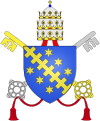 |
| Vndoſus uir. | |||||
| 234 | 78 Wavy man | Leo XI (1605) | Alessandro Ottaviano De Medici | He had been the Bishop of Palestrina.[57] The ancient Romans attributed the origins of Palestrina to the seafaring hero Ulysses.[58] Also, he had only reigned for 27 days. |  |
| Gens peruerſa. | |||||
| 235 | 79 Corrupted nation | Paul V (1605–1621) | Camillo Borghese | Pope Paul scandalised the Church when he appointed his nephew to the College of Cardinals. The word "nepotism" may have originated during this pope's reign.[59] |  |
| In tribulatione pacis. | |||||
| 236 | 80 In the trouble of peace | Gregory XV (1621–1623) | Alessandro Ludovisi | His reign corresponded with the outbreak of the Thirty Years' War. |  |
| Lilium et roſa. | |||||
| 237 | 81 Lily and rose | Urban VIII (1623–1644) | Maffeo Barberini | He was a native of Florence, which has a red lily on its coat of arms.[60] |  |
| Iucunditas crucis. | |||||
| 238 | 82 Delight of the cross | Innocent X (1644–1655) | Giovanni Battista Pamphili | He was raised to the pontificate around the time of the Feast of the Exaltation of the Cross after a long and difficult conclave. |  |
| Montium cuſtos. | |||||
| 239 | 83 Guard of the mountains | Alexander VII (1655–1667) | Fabio Chigi | His family arms include six hills with a star above them.[61] |  |
| Sydus olorum. | |||||
| 240 | 84 Star of the swans | Clement IX (1667–1669) | Giulio Rospigliosi | The "star" in the legend refers Pope Alexander VII, who had made Clement his personal secretary.[61] The Italian word for swan, cigni, rhymes with Pope Alexander's surname, "Chigi." |  |
| De flumine magno. | |||||
| 241 | 85 From a great river | Clement X (1670–1676) | Emilio Altieri | Pope Clement was a native of Rome. | 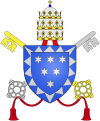 |
| Bellua inſatiabilis. | |||||
| 242 | 86 Insatiable beast | Innocent XI (1676–1689) | Benedetto Odescalchi | Pope Innocent had a lion on his coat of arms.[61] |  |
| Pœnitentia glorioſa. | |||||
| 243 | 87 Glorious penitence | Alexander VIII (1689–1691) | Pietro Ottoboni | His first name was "Pietro", after the apostle Peter who had repented after having denied Christ thrice. |  |
| Raſtrum in porta. | |||||
| 244 | 88 Rake in the door | Innocent XII (1691–1700) | Antonio Pignatelli del Rastrello | His full name was Antonio Pignatelli del Rastrello.[62] "Rastrello" in Italian means "rake." | 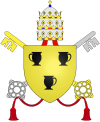 |
| Flores circundati. | |||||
| 245 | 89 Surrounded flowers | Clement XI (1700–1721) | Giovanni Francesco Albani | He had been a cardinal with the title of Santa Maria in Aquiro.[63] |  |
| De bona religione. | |||||
| 246 | 90 From good religion | Innocent XIII (1721–1724) | Michelangelo dei Conti | A play on words, referring to the pope's regnal name. He was from the famous Conti family that had produced several Popes. |  |
| Miles in bello. | |||||
| 247 | 91 Soldier in War | Benedict XIII (1724–1730) | Pietro Francesco Orsini | Before he was pope there was a lot of wars in nearby countries, and it is possible he could have fought in one as a soldier. |  |
| Columna excelſa. | |||||
| 248 | 92 Lofty column | Clement XII (1730–1740) | Lorenzo Corsini | When still a cardinal, he had held the titular church of St Peter in Chains.[64] The name "Peter" is derived from the Greek word "petros," meaning "rock." Clement was a frustrated architect who ordered, and sometimes interfered with, the building of many churches. He managed to salvage two columns of the Parthenon for his chapel at Mantua. |  |
| Animal rurale. | |||||
| 249 | 93 Country animal | Benedict XIV (1740–1758) | Marcello Lambertini | Might be a play on words because of his famous laws about missions in the two papal bulls'‘. |  |
| Roſa Vmbriæ. | |||||
| 250 | 94 Rose of Umbria | Clement XIII (1758–1769) | Carlo Rezzonico | He had been a cardinal with the titular church of Santa Maria in Aracoeli.[65] In mystical circles, the Virgin Mary is represented by a rose. | 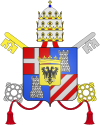 |
| Vrſus uelox. | |||||
| 251 | 95 Swift bear (later misprinted as Cursus velox Swift Course or Visus velox Swift Glance) | Clement XIV (1769–1774) | Lorenzo Giovanni Vincenzo Antonio Ganganelli | The Ganganelli family crest bore a running bear.[4] |  |
| Peregrin9 apoſtolic9.[66] | |||||
| 252 | 96 Apostolic pilgrim | Pius VI (1775–1799) | Giovanni Angelico Braschi | Spent the last two years of his life in exile, a prisoner of the French Revolution. |  |
| Aquila rapax. | |||||
| 253 | 97 Rapacious eagle | Pius VII (1800–1823) | Barnaba Chiaramonti | The Pope's pontificate was overshadowed by Napoleon, whose emblem was the eagle. |  |
| Canis & coluber. | |||||
| 254 | 98 Dog and adder | Leo XII (1823–1829) | Annibale Sermattei della Genga | "Dog" and "snake" are common insults, and Leo was widely hated[citation needed]. The legend could be an allusion to the pope's last name, Sermattei. "Serpente" is the Italian word for snake. |  |
| Vir religioſus. | |||||
| 255 | 99 Religious man | Pius VIII (1829–1830) | Francesco Saverio Castiglioni | Another play on words, referring to the pope's regnal name. |  |
| De balneis Ethruriæ. | |||||
| 256 | 100 From the baths of Tuscany | Gregory XVI (1831–1846) | Mauro, or Bartolomeo Alberto Cappellari | Pope Gregory XVI belonged to the Camaldolese Order, which is said to have begun with two monastic houses. The first of these houses was Campus Maldoli, and the second was Fonte Buono, meaning "good fountain" in Italian.[67] |  |
| Crux de cruce. | |||||
| 257 | 101 Cross from cross | Bl. Pius IX (1846–1878) | Giovanni Maria Mastai Ferretti | During his pontificate, the House of Savoy, whose coat of arms is a white cross on a red background, reunited Italy and stripped the pope of his territorial possessions. Pope Pius XII, commenting on the beatification process of Pius IX, used the words per crucem ad lucem (through the cross to light). Pius IX was finally beatified by Pope John Paul II in 2000. | |
| Lumen in cœlo. | |||||
| 258 | 102 Light in the sky | Leo XIII (1878–1903) | Gioacchino Pecci | His coat of arms had a shooting star.[4] | 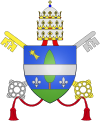 |
| Ignis ardens. | |||||
| 259 | 103 Burning fire | St. Pius X (1903–1914) | Giuseppe Sarto | Pius advocated the codification of Canon law, daily communion and the use of Gregorian chant in the Catholic liturgy, and was an opponent of Modernism. He was the first pope to be declared a saint in over 400 years, the previous one being Pope Pius V. |  |
| Religio depopulata. | |||||
| 260 | 104 Religion destroyed | Benedict XV (1914–1922) | Giacomo Della Chiesa | Reigned during, but had no influence to stop, World War I. This unprecedented period of violence was mainly fought between the Christian powers of Europe, destroying empires which had lasted centuries and began the worldwide spread of atheistic Communism.[4] |  |
| Fides intrepida. | |||||
| 261 | 105 Intrepid faith | Pius XI (1922–1939) | Achille Ratti | Established Vatican City as a sovereign country with the papal office as head of state. | 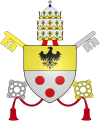 |
| Paſtor angelicus. | |||||
| 262 | 106 Angelic shepherd | Ven. Pius XII (1939–1958) | Eugenio Pacelli | Reigning during World War II, he is reported to have covertly helped many Jews escape extermination in the Holocaust, though his role continues to be fiercely debated. Said to have received visions,[citation needed] some of which have yet to be revealed.[citation needed] |  |
| Paſtor & nauta. | |||||
| 263 | 107 Shepherd and sailor | Bl. John XXIII (1958–1963) | Angelo Giuseppe Roncalli | Patriarch of Venice, a maritime city (and a fomer naval power), from 1953 until 1958 (when he was elected Pope). |  |
| Flos florum. | |||||
| 264 | 108 Flower of flowers | Paul VI (1963–1978) | Giovanni Battista Enrico Antonio Maria Montini | His coat of arms featured three fleurs-de-lis.[4] |  |
| De medietate lunæ. | |||||
| 265 | 109 From the midst of the moon | John Paul I (1978) | Albino Luciani | His month-long reign began with the moon half-full[citation needed]. |  |
| De labore solis. | |||||
| 266 | 110 From the labour of the sun | Bl. John Paul II (1978–2005) | Karol Wojtyła | Born (18 May 1920) on the day of a solar eclipse[68][69] and entombed (Friday April 8, 2005) on the day of a solar eclipse.[70] Writing before that second eclipse, Tony Allan had said that attempts to find a connection between 'from the labour of the sun' and John Paul II 'by pointing out that he came from Krakow, the birthplace of Copernicus, who first expounded the Earth's solar orbit, seem forced.' [4] |  |
| Gloria olivæ. | |||||
| 267 | 111 Glory of the olive. | Benedict XVI (2005–2013) | Joseph Ratzinger | Chose the regnal name Benedict after St Benedict of Nursia, founder of the Benedictine Order. The order's crest contains an olive branch.[citation needed] Since 1960, one of (currently) 20 congregations in the Benedictine Confederation has been the Olivetans (founded in 1313), whose name ultimately derives from the Mount of Olives in the New Testament. Notably, Pope Benedict XVI is personally unaffiliated with the Olivetan order. |  |
| In pſecutione extrema S.R.E. ſedebit. | |||||
| In the extreme persecution of the Holy Roman Church, there will sit.[71] | |||||
| Petrus Romanus, qui paſcet oues in multis tribulationibus: quibus tranſactis ciuitas ſepticollis diruetur, & Iudex tremẽdus iudicabit populum ſuum.[72] Finis. | |||||
| 268 | 112 Peter the Roman, who will nourish the sheep in many tribulations; when they are finished, the city of seven hills will be destroyed, and the dreadful judge will judge his people. The end. | Unknown | Unknown | The Catholic Encyclopedia, an independent American research company, has said that, even if the prophecy is genuine, which it doubts, there may still be many Popes between Peter the Roman and his predecessor on this list.[73] | |
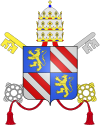
No comments:
Post a Comment